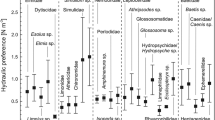Abstract
The degree of sediment disturbance in the South Pass area is correlated to the average hydraulic conductivity, shear strength, and thermal gradient. Hydraulic conductivity averages 18, 6, and 4 × 10−7 cm/s in the undisturbed, moderately disturbed, and most disturbed sediments, respectively. Shear strength also decreases with increasing disturbance, from 7.6 to 4.4 to 3.5 kPa. Excluding the four stations dominated by annual temperature variations, the remaining 19 thermal gradients correlate well with sediment disturbance. The average gradient is positive in all of the disturbed sediments (0.12 ± 0.07° C/m) and 0 in the undisturbed sediments (0.02 ± 0.05° C/m).
Similar content being viewed by others

References
Coleman JM, DB Prior (1979) U.S. Geological Survey Mississippi Delta Project, Plate 5, Sea Floor Morphology (Map)
Shepard FP (1955) Delta-front valleys bordering the Mississippi distributaries. Bulletin Geological Society of America 66:1489–1498
Coleman JM (1981) Deltas, Processes of Deposition and Models for Exploration. Burgess, Minneapolis, 124 pp
Henkel DJ (1970) The role of waves in causing submarine landslides. Geotechnique 20:75–80
Hirst TJ, Richards A (1976) Excess pore pressure in Mississippi Delta front sediments: initial report. Marine Geotechnology 1:337–334
Prior DB, Suhayda JN (1979) Application of infinite slope analysis to subaqueous sediment instability, Mississippi Delta. Engineering Geology 14:1–10
Prior DB, Coleman JM (1982) Active slides and flows in underconsolidated marine sediments on the slopes of the Mississippi delta. In: Saxov S, Nieuwenhuis JK (eds) Marine Slides and Other Mass Movements, Nato Conference Series IV:6 Plenum Press, New York, 21–50
Prior DB, Coleman JM (1978) Disintegrating, retrogressive landslides on very low angle subaqueous slopes, Mississippi Delta. Marine Geotechnology 3:37–60
Gibson RE (1958) The progress of consolidation in a clay layer increasing in thickness with time. Geotechnique 8:171–182
Langseth MG, Hobart MA, Horai K (1980) Heat flow in the Bering Sea. Journal Geophysical Research 85:3740–3750
Lambe W, Whitman RV (1979) Soil Mechanics. John Wiley, New York, 553 pp
Bohlke BM, Bennett RH (1980) Mississippi Prodelta crusts: A clay fabric and geotechnical analysis. Marine Geotechnology 4:55–82
Esrig MI, Kirby RC, Bea RG, Murphy BS (1977) Initial development of a general effective stress method for the prediction of axial capacity for driven piles in clay. Proceedings 9th Annual Offshore Technology Conference, Houston, pp 495–506
Bennett RH, Burns JT, Clarke TL, Faris JR, Forde EB, Richards AF (1982) Piezometer probes for assessing effective stress and stability in submarine sediments. In: Marine Slides and Other Mass Movements. Saxov S, Nieuwenhuis JK (eds), NATO Conference Series IV:6, Plenum Press, New York, pp 129–162
Abbott DH, Menke WH, Hobart M, Anderson RN, Embley RW (1984) Correlated sediment thickness, temperature gradient, and excess pore pressures in a marine fault block basin. Geophysical Research Letters 11:485–488
Anderson RN, Hobart MA, Langseth MG (1979) Convective heat transfer in oceanic crust and sediment in the Indian Ocean. Science 204:828–832
Caldwell DR, Chriss TM, Newberger PA, Dillon TM (1981) The thinness of oceanic temperature gradients. Journal Geophysical Research 86:4290–4292
Goguel J (1976) Geothermics. McGraw-Hill, New York, 200 pp
Whelan T, Coleman JM, Suhayda JN, Garrison LE (1975) The geochemistry of recent Mississippi River Delta sediments: gas concentration and sediment stability. Proceedings 7th Offshore Technology Conference, Houston:71–85
Johns MW, Taylor E, Bryant WR (1982) Geotechnical sampling and testing of gas-charged sediments at in situ pressures. Geo-marine Letters 2:231–236
Nowlin WD Jr, Parker CA (1974) Effects of a cold-air outbreak on shelf waters of the Gulf of Mexico. Journal of Physical Oceanography 4:467–486
Roberts HH, Cratsley DW, Whelan III T (1976) Stability of Mississippi Delta sediments as evaluated by analysis of structural features in sediment borings, Proceedings 8th Offshore Technology Conference, Houston:9–28
Bredehoeft JD, Papadopoulos IS (1965) Rates of vertical groundwater movement estimated from the earth's thermal profile. Water Resources 1:325–328
Abbott DH, Menke WH, Hobart MA, Anderson RN (1981) Evidence for excess pore pressures in southwest Indian Ocean sediments. Journal Geophysical Research 86:813–828
Burst JF (1969) Diagenesis of Gulf Coast clayey sediments and its possible relationship to petroleum migration. Bulletin American Association Petroleum Geologists 53:73–93
Clark SP (ed) (1966) Handbook of Physical Constants. Geological Society of America Memoir 97, p 464
McGregor BA, Bennett RH, Lambert DN (1979) Bottom processes, morphology and geotechnical properties of the continental slope south of Baltimore Canyon. Applied Ocean Research 1: 177–187
Bryant WR, Deflache AP, Trabant PK (1974) Consolidation of marine clays and carbonates. In: Inderbitzen A (ed) Deep Sea Sediments: Physical and Mechanical Properties. Plenum Press, New York pp 218–219
Whelan T, Coleman JM, Suhayda JN, Roberts HH (1977) Acoustical penetration and shear strength in gas charged sediments. Marine Geotechnology 2:147–159
Author information
Authors and Affiliations
Rights and permissions
About this article
Cite this article
Abbott, D.H., Embley, R.W. & Hobart, M.A. Correlation of shear strength, hydraulic conductivity, and thermal gradients with sediment disturbance: South Pass region, Mississippi Delta. Geo-Marine Letters 5, 113–119 (1985). https://doi.org/10.1007/BF02233936
Received:
Revised:
Issue Date:
DOI: https://doi.org/10.1007/BF02233936



